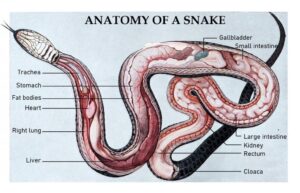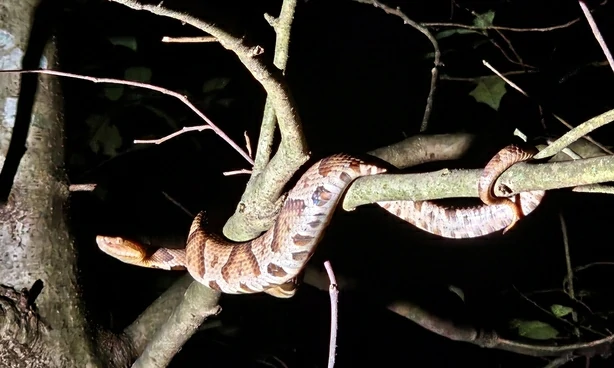If you’ve ever seen a snake with a short, stubby tail or a funny-looking scar near the end of its body, you might wonder. can snakes grow their tails back? It’s a fair question, especially since some other reptiles, like lizards, are famous for dropping and regrowing their tails.
Snakes cannot regrow their tails once they lose them. This is one of the things that separates snakes from lizards and other reptiles that can regenerate parts of their body. If a snake loses part of its tail, that piece is gone for good.
But even though they can’t grow a new one, snakes are strong survivors. They adapt in ways that might surprise you.
Let’s take a closer look at how snakes’ tails work, why they matter, and what happens when they’re lost.
What Counts as a Snake’s Tail?
To understand why tail loss matters, it helps to know how a snake’s body is built. While a snake might look like one long tube, its body is divided into four main parts: the head, neck, trunk, and tail.
The tail begins right after the snake’s vent, also called the cloaca.

This is the opening near the back end of the body where waste and reproductive fluids come out. Everything behind that is considered the tail.
The tail might seem like a small part of a snake, but it’s more important than it looks. It contains bones, muscles, nerves, and skin; all working together to help the snake survive in the wild.
Why the Tail Is So Important
Snakes use their tails for more than just balance. In fact, the tail helps with a lot of daily activities.
Movement and balance come first. As a snake slithers, its tail helps it stay balanced and stable.
Whether it’s climbing a tree or swimming through a pond, the tail acts like a rudder, steering the body in the right direction.
Communication is another key use. Some snakes shake or vibrate their tails to make noise, especially when they feel threatened.
Even non-venomous snakes will sometimes mimic the behavior of rattlesnakes by vibrating their tails against dry leaves to scare off predators.
Defense and distraction can also come into play. In some cases, snakes might use their tails to draw attention away from their heads.
This can confuse predators, especially if the tail is brightly colored or shaped to look like a second head.
So when a snake loses its tail (or even part of it) it can affect how the animal moves, defends itself, and interacts with the world.
Why Snakes Can’t Regrow Their Tails
Now back to the big question. If a snake loses its tail, why can’t it just grow a new one like a lizard?
The reason is simple: snakes don’t have the same body structures that make regeneration possible in other animals. Lizards, for example, have special weak points in their tail bones called “fracture planes.”
These allow them to snap off their tails cleanly when attacked, and their bodies can regrow new tails made of cartilage.
Snakes don’t have fracture planes. Their tails are made of tightly connected bones and muscle, with no natural breaking point.
That means they can’t drop their tails on purpose, and their bodies aren’t set up to replace them afterward.
Even if a snake’s tail is accidentally injured or bitten off, there’s no biological system in place to trigger tail regrowth. Once that part is gone, it stays gone.
What Happens When a Snake Loses Its Tail?
While snakes can’t grow their tails back, that doesn’t mean it’s the end for them. Many snakes survive just fine with shortened or damaged tails.
If a predator attacks and bites off part of the tail, the snake might bleed and be in pain, but if the injury isn’t too severe, it can still recover.
Over time, scar tissue will form over the wound, sealing it and protecting the rest of the body from infection.
The scarred area may look rough or uneven, but the snake can still slither, hunt, and live its life.
How Snakes Adapt to Life Without a Full Tail
Snakes are great at adjusting when something goes wrong. If they lose part of their tail, they find ways to keep going.
They may change how they move, relying more on their trunk muscles to keep balance. Climbing may become harder, but ground movement remains possible.
Their hunting style may shift too. A snake that once relied on stealth and speed might become more cautious, striking from cover instead of chasing prey. Many snakes are ambush hunters anyway, so a missing tail doesn’t always ruin their chances.
They may also change how they defend themselves. A tail is often used as a decoy or noise-maker, and without it, the snake might rely more on camouflage, hiding in thick vegetation or under rocks.
Types of Tail Injuries in Snakes
Not all tail damage is the same. Here are a few common types:
- Complete tail loss – When the entire tail is bitten or ripped off. This is the most serious and affects balance the most.
- Partial tail loss – A portion of the tail is missing, but not all of it. This is easier to adapt to.
- Crushed or bruised tail – The tail is still attached but damaged. Healing may take time, but full function can return.
- Open wounds or cuts – These can become infected if not treated, especially in pet snakes.
In wild snakes, these injuries often go untreated. But snakes have strong immune systems and can recover from a lot.
What Causes Tail Injuries?
There are several ways a snake can end up with a damaged tail:
- Predator attacks – Birds, mammals, or other reptiles may bite at the tail as the snake tries to escape.
- Accidents in the wild – Getting caught in tight spaces or hit by falling debris can cause injury.
- Human activity – Lawn mowers, cars, and even mishandling by people can lead to broken or lost tails.
- Cage injuries in captivity – Pet snakes sometimes hurt their tails on sharp enclosure edges, heating equipment, or cage mates.
Injuries from humans (whether accidental or out of fear) are sadly common. This is why it’s so important to treat wild snakes with care and respect.
What To Do If You Find an Injured Snake
If you ever come across a snake with an injured or missing tail, the best thing you can do is leave it alone. Snakes, even injured ones, can still bite. A scared, hurt animal is more likely to defend itself.
If the snake is in immediate danger (like on a road or in a high-traffic area) you can call a wildlife rescue or a reptile expert. These people are trained to handle snakes safely and know what care they need.
Never try to catch or treat a wild snake on your own. Even non-venomous snakes can deliver a painful bite if they feel threatened.
Can Captive Snakes Survive Tail Injuries?
Yes. Pet snakes can live long, healthy lives after tail injuries, especially if the wound is cleaned properly and they’re kept in a stress-free environment. Reptile vets can provide antibiotics or surgery if needed.
Owners should be careful with handling and cage design. Sharp cage decor, overheating, or other pets can lead to accidents. Snakes kept with others (like in breeding setups) should always be watched for signs of aggression or stress.
Why This Matters: Tail Loss and Snake Conservation
Understanding that snakes can’t regrow their tails helps us see why they need to be handled gently and protected in the wild.
Many people are still afraid of snakes and hurt them out of fear. But snakes aren’t the monsters some people think they are. In truth, they’re helpful, shy, and a vital part of nature.
Snakes help control rodent populations, which protects crops and limits disease. Without snakes, ecosystems can quickly fall out of balance.
And when snakes are injured by human tools or frightened into defensive bites, they’re usually the ones who suffer.
Conclusion
So no, snakes can’t regrow their tails, but that doesn’t stop them from being incredible creatures.
Even after injury, a snake will adjust, adapt, and keep going. It may not move quite the same way. It may not hunt as easily. But it will survive, and that alone shows just how tough these reptiles really are.
Next time you see a snake with a scarred or shortened tail, remember: it’s not broken, it’s a survivor.
And maybe, just maybe, it’s a little wiser than it was before.
Hi, my name is Ezra Mushala, i have been interested animals all my life. I am the main author and editor here at snakeinformer.com.

